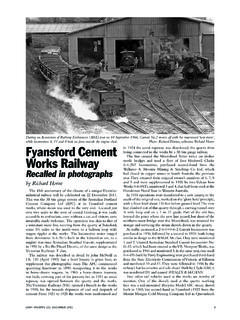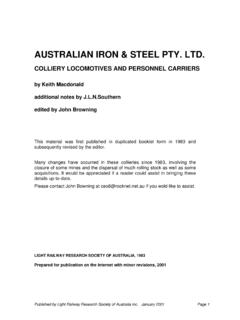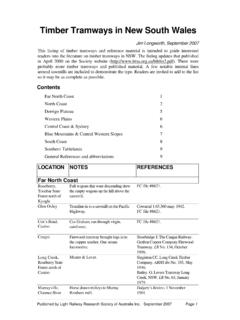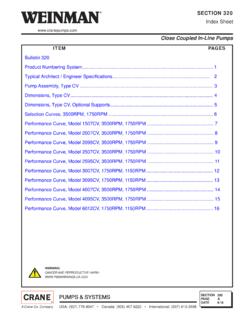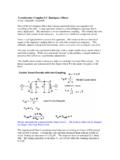Transcription of Krauss Locomotives in Australia A close look at their ...
1 Krauss Locomotives in AustraliaA close look at their characteristics and an overview of their migrationsby Bruce MacdonaldAt the time that Charlie Small and I embarked on the studyof Krauss Locomotives in Australia in 1961, it represented aground-breaking approach wherein the entire Australian distribution of the products of one manufacturer was tracedin detail. The results were published in the ARHS BulletinNo. 391 of May 1970. Since that time more information hascome to hand which corrects and adds to that of thirty yearsago. It was therefore considered appropriate that, as an addendum to Peter Evans contribution on Krauss agencies(see LR 150) covering the Company s most productive periodas far as Australian useage is concerned, our original study berevised and updated accordingly. It does not claim to be adefinitive work because there are still a lot of uncertaintieswhich may, in the future, be resolved.
2 All constructive commentsare to the publication of the ARHS article, I wasfortunate in obtaining photocopies of the Krauss order booksthrough Dr Gerhard Nicolai, an engineer with Krauss -Maffei. These disclosed previously unknown details of built Locomotives of every conceivable gauge from15in to 5ft 6in for all parts of the world. While they specialised in small industrial and light railway types they alsobuilt many main line Krauss company amalgamated with Maffei A G in1931 to form Krauss -Maffei. A G. Maffei had built 5,896locomotives at its Munich works during the period from1831 to new company exists today as a manufacturerof railway and heavy engineering products. The Leopard tanks used by the Australian Army were made by has been found that Krauss adopted a sophisticated systemof standard designs and parts and this system was used in theidentification of individual Locomotives or groups of of Locomotives having common characteristics would bemanufactured with a identification using Roman production groups would be identified by a subgroup of letters in lower case.
3 ( XIV ff). The latter wouldprogress through the alphabet to reflect subsequent productionsand would be repeated after page of the order book is reproduced opposite, and itshows, in column order, the factory in which the loco was built, being either Sendling or Marsfeld in the Municharea or at Linz in Austria. The next columns show the serial number, class and subclass, gauge in mm, horsepower,number of axles, loco name and/or road number if given,customer, date ordered, date required for completion, datedespatched, weight in kg, price and shipping point. Withregard to the number of axles, if a four coupled loco had abogie it was shown as 2/3 but there is no indication if it was a2-4-0 or 0-4-2. It will be seen that above the 2584 there is anote telling that there are ten items in that production batch of30-40 horsepower tank engines. It should be noted that on theContinent, tank engines are referred to as tenderlokomotivs.
4 The majority of 0-4-0T Locomotives for Australia were 30horse power class IV. There is an anomaly here because in thisquantity there are some which weigh tons and have 160mm diameter cylinders and others which weigh tons with180 mm diameter cylinders, so I cannot understand how theycould be of equal horsepower. Even the boilers were differentfor each, although each had 175 psi ten-ton 0-4-0T s had 225mm diameter strokeof 300mm was common for all. Driving wheels were 600mmdiameter disc type with two holes for access for oiling the ton 0-4-0Ts and 6854 had spoked is that the four-coupled engines had Alligator typecross-heads (two bars) but six-coupled engines had Laird type(single bar). I am unable to see a practical reason for 2591 whilst in the employ of Wadey at the Heatherton Asylum project. Note the radiused top corners of the front plate. Also the Sunflower top to the chimney, typical of the original equipment on these early locos, but which seemed to be discarded early.
5 Photo: Bruce Macdonald collectionLIGHT RAILWAYS 153 JUNE 200010 Krauss were pioneers in the adaption of the main chassis toincorporate a water tank, known as a well tank . This hadthe effect of lowering the centre of gravity of the loco andbecame a feature of small Continental built locos. A sideeffect of this was that it necessitated the use of outside valvemotion which, in the case of Krauss , was of the Stephenson type. These features were typical on those locos supplied toAustralia, except 6854 which had Walschaert valve gear. Ourten-ton 0-4-0Ts and 0-6-0Ts, except serial Nos. 3444, 6415and 6416, had supplementary side the 0-4-0T type prior to the throttle valve,attached to the front of the dome, had a flat, horizontal topcover. Subsequently this cover was domed and set at about 45degrees. Prior to 2459 the rectangular front buffer plate hadsquare corners. Subsequently they were radiused on the topcorners.
6 From 3267 all four corners were radiused. From3423 to 4387 the safety valves were like buffalo horns on topof the dome. Prior and after, they were the Salter type withthe vertical springs behind the dome. Prior to 4526 the cabwindows were eliptical. Subsequently they were round. All 0-6-0Ts except 3444 had round windows. On class XIV thevalve chest on the cylinders was placed towards the rear ofthe cylinder as opposed to the front. In all cases, the valvespindle had incorporated in it a turnbuckle with a left andright screwed thread, which allowed the easy adjustment ofvalve travel to provide the required lap and lead .Of course there are the inexplicable exceptions - 3263, 3266,4722, 5679 and all the ten-ton locos had rectangularcab windows. 3267 & 4387 had a much thicker front buffer beam (illustrated on pages 5 and 8 of LR 150).The four locos at Burrenjuck had the dome centrally placedon the boiler instead of close to the the following listing, the Krauss serial number is shownwith the date, number of axles, gauge in mm, horsepower,class type and selling agency.
7 Below this is a chronology of itsownerships. It must be understood that the dates should notbe taken as specific in all cases due to the vagueness of someinformation. A year either side of the date given may reference figures show the source of the later entries are from the former work or the author would like to acknowledge and thank those persons whohave contributed their information to increase this commonwealth of following abbreviations denote the agent. SKA=Shadler, Koeniger & Aron, B= Bloomfield Bros, D= Diercks& Co., L= Lohmann & Co., AK= Arthur Koppel. The word stored or St means that the loco was out of regular use orpossibly abandoned, The word scrapped or Sc. is used toimply that it was dismantled to a point of being largely question mark signifies an unknown or code WA, SA, V, NSW, Q and T following the ownersname denotes the Australian state in which the ownershipexisted, being Western Australia , South Australia , New SouthWales, Queensland and Tasmania.
8 In some cases the originalowning Company changed name or ownership during thetime of the loco s tenure and this is shown by following with-out wider spacing - J Smith (1922) Smith & Insome cases irrelevant changes are not some engines or groups of engines a commentary onthe data or lack of data helps clarify the regardto the seven ton locos owned by Mt. Lyell, it has been difficult to trace specific locos through the boiler recordsbecause, the boiler inspection authority, having issued an official boiler number at the initial loco inspection, expectedthis boiler to remain with that loco. However, boilers could beswapped from loco to loco during overhauls, creating confusionboth for the inspectors and Locomotives IN AUSTRALIAS erial Table1824 1888 2/2 600 20 IV hSKA1888 - Displayed at Melbourne Centennial Exhibition (V).21889 - unknown buyer. 1900 - WA Builder s Lime & Stone (WA).51905 - Briggs & Co.
9 Perth (WA) J Haydon Perth (WA) - Kalgoolie & BoulderFirewood Co. Beria (WA). 1935 - Derelict at Beria - 1889 2/2 610 30 IV qqSKA1889 - J Robb for Victoria Dock Construction (V). 1892 -SA Water Supply, Happy Valley Reservoir - unknown. - Hassell Marion BayGypsum Co. (SA). 1925 - Victor Electric Plaster Mills - stored. c 1950 - 1889 2/2 610 30 IV qqSKA1889 - J Robb for Victoria Dock Construction (V). 1892 -SA Water Supply Happy Valley Reservoir - unknown, possible contract job in - Norton Griffith contract for NSW -NSW Public Works Dept. - NSW Govt RwysNo. Lo - Newbold Silica & Firebrick Co. Pattimorequarry (NSW). 1938 - converted to petrol engined by adaptionof Leyland truck engine. 1945 - transferred to Home Rulequarry. 1947 - - donated to Illawarra Light RailwayMuseum Society (NSW).72180 1889 2/2 610 30 IV - J Robb for Victoria Dock Construction (V).
10 1892 -SA Water Supply, Happy Valley Reservoir - Tasmanian Govt Rwys 1. - - 1889 2/2 610 30 IV - J Robb for Victoria Dock Construction (V). 1892 -SA Water Supply, Happy Valley Reservoir - Unknown. 1903 - East Murchison Unitedmine. (WA).51919 - Western Machinery Co., Kalgoorlie(WA).51963 - Aust. Rwy Historical Society (WA).5 1984-WALt Rwy Pres. Assoc., Caversham (WA)11 LIGHT RAILWAYS 153 JUNE 200012No. 1824, in use at the Lancefield Goldmine, Beria, with KalgoorlieBoulder Firewood Co., circa 1910. Photo: Adrian Gunzburg collection2195 1889 2/2 610 30 IV ssSKA1889 - J Robb for Victoria Dock Construction (V). 1892 -SA Water Supply, Happy Valley Reservoir - J Robb s Cudgen sugar mill.(NSW). 1912 - ColonialSugar Refining Co. - Transferred to CSR CondongMill (NSW). - 1889 2/2 610 30 IV ssSKA1889 - J Robb for Victoria Dock Construction (V). 1892 -SA Water Supply, Happy Valley Reservoir - Unknown.
